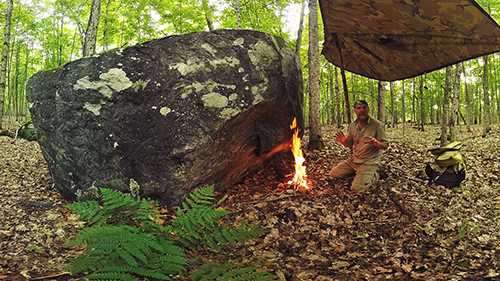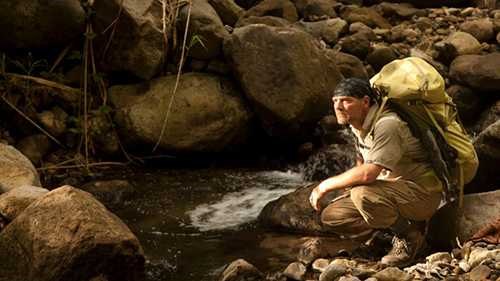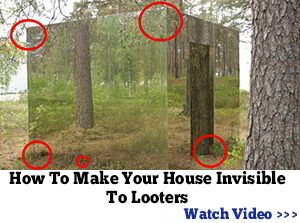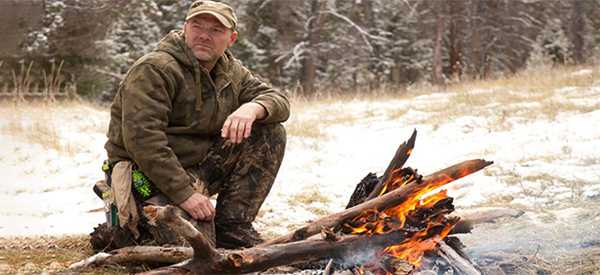When you are preparing to go into the wild, whether for a backcountry hike or hunting trip or even just for a short hike and overnight camping trip, you should have a basic knowledge of survival skills. Who better to look to for advice for building your knowledge of survival techniques than from one of the most decorated and well-known survivalists, Les Stroud.
In this article, we will outline 20 survival tips that are supported by Les Stroud and will help you prepare for and make the right decisions when in the field. We will focus on tips that are universal to any location or climate, though if a tip is more geared toward specific areas or weather conditions we will be sure to make it clear to you.
#1. Anytime you are traveling away from civilization you should have the ability to make fire quickly. This is a universal survival tip for wherever you are in the world. While having the skill to make fire from your surroundings is great to have, make it much easier on yourself and have a durable butane lighter and the large, weather proof matches to get a fire started quickly.
#2. Survival is much easier when you are fully prepared for it. While not every situation allows you to properly pack and prepare, most of the time you will have a pack or gear with you when hiking out in the wilderness. Les is a firm believer in carrying a good multi-tool with you at all times. It will allow you to dig, cut, scrape, and even field dress and prepare caught game. Not only that, but a multi-tool is highly portable and is not going to weigh you down as much as you would trying to carry all of the tools separately.
#3. Like the last two tips, Les harps on being prepared when you travel in the wilderness. While it is a skill all on its own to build a shelter from the materials around you, why waste the energy when you could have a light and portable shelter with you that you can have put up in a few minutes? A tarp or other durable material gives you a quick shelter to get out of the rain, snow, and wind. If you have to build a more permanent shelter, this piece of gear will still be useful in its design.
#4. If possible, have some piece electronic equipment that will allow you to reach out to the outside world when backpacking. If you can’t reach out electronically, smoke signals are your best bet. Burn damp wood chips or vegetation over hot coals to produce a lot of smoke quickly. Having a whistle or other gear that produces long range noise is also a useful piece of equipment, but Les does stress that odd noises in some environments can attract large and curious predators.
#5. Even if you bring a decent food supply with you, there is a chance you can run out and will have to resort to eating vegetation. There is the chance some vegetation is poisonous and will cause you more harm than being hungry. Luckily, there is a universal test that Les utilizes to determine if certain vegetation is edible. Rub the vegetation on the skin and wait several hours to a day and look for skin irritation. If none, rub the vegetation lightly on your lips. Again, look for irritation after several hours to a day. Next, chew and spit out the vegetation, be sure not to ingest and wait as previously. If you still have not noticed any irritation, swelling, or stomach issues, it is most likely safe to eat.
Related: 16 Wild Edibles You Didn’t Know You Could Forage For
#6. If you have the means to construct land or water based traps you can snare large sources of protein and fat. While this meat can be a huge advantage to your survival, undercooked meat can be a source of parasitic and bacterial infection. Be sure to cook your meat well done before consuming. Les also advises eating every part of the animal except for the entrails. This provides you with a much wider range of nutrients other than protein.
#7. Insects can be a readily available source of protein in the wild and are much easier to catch and consume than larger game. With that, there are some precautions that you need to take before ingesting insects. Like vegetation, some insects are poisonous and consuming them can cause a lot of harm. Les recommends staying away from brightly colored insects, slow moving insects, and insects that emit unpleasant smells as these are often signs of insects that are poisonous and consumption should be avoided.
#8. Even when you find sources of water, it doesn’t mean it is safe for drinking. There are plenty of chemical and filter treatments available to you and should be carried with you when heading out into the wild. Les still recommends some basic survival techniques for generating clean water free of parasites. Some of this includes a solar still, cutting certain vegetation such as water vines and collecting water, collecting rain water, and using heated stones from your fire to boil water if you do not have a fire-resistant container.
#9. Wood is a vital resource when trying to survive. It will allow you to build more durable and protective shelters as well as serve as a fuel source. Les recommends scouting available wood and building up a fuel source early in a survival situation. One tip he gives you making more usable sizes of wood is to use two trees to provide enough leverage to break larger pieces of wood easily without risking injury. Here are 10 trees every survivalist should know.
#10. While Les recommends carrying a lighter or device to start fires quickly, he also recommends several other tips to starting fire by other methods. It’s one of the most important skills for survival as it provides warmth, deters predators, and provides a method to cook food. One of the Survivorman’s favorite tips is the use of a camera lens or other magnifying glass to direct sunlight on kindling to start a fire. You can also fill a cotton sock stuffed with tinder and use the spark from an empty lighter to start a fire consistently. Of course, you have to weigh the pros and cons to losing a sock.
#11. When in a true survival situation, it is critical that you provide all of the signs and signals that can help people find you. Les advises you use the noise for a noise rule when in the wild. This is, when you hear a loud noise that might be made by other people, you answer back with a loud noise. Animals will often run from this noise, but a human is prone to make another loud noise. If you continue answering back, they are likely to be curious and come into your area.
#12. For a long time, the adage of survival is to stay put and wait for help to come. While Les understands that there are situations where this is the right strategy, if you can walk out on your own you should do it. Walking out plays hand in hand with knowing the area and marking your path. If you have a firm grasp on main river channels and where they lead from reading maps or have marked your trail you should try to get out before your situation turns worse.
#13. You should never be traveling out in the wilderness without there being several people you trust back home knowing where you are going and that have a definitive timetable for when you should return. The Survivorman greatly stresses this on multiple occasions and is the best possible strategy to ensure people come looking for you.
Related: What You Need in Your SHTF Survival Team
#14. We have covered several key pieces of gear that Les recommends carrying with you anytime you are out in the wild. Duct tape, of any reliable brand, can serve a huge number of purposes while in the field. It can repair damaged gear, hold together shoes or boots, be used in first aid, and help provide more structure to shelter. It doesn’t take up much room in your pack and can be one of the most useful pieces of gear you can have on your person.
#15. While the best case scenario would be to have access to both water and food immediately, it’s not always the case. Water is going to be your priority as the body can go much longer without food than it can with water. Even if you have a supply of food around you, water is still critical to find for hydration purposes as most food is not going to supply enough moisture to sustain you. Water is also necessary to fully digest and get as much energy and nutrients out of food as you can.
#16. Les Stroud constantly harps on having a firm understanding of the area you are going to be traveling. This consists of knowing the terrain, trails, and river systems from maps as well as an understanding of the weather and temperatures you are likely to encounter. You should also be familiar with the type of vegetation as well as dangerous animals you might come across and how to deal with them. All of this knowledge allows you to dress and pack needed gear that can get you through a potential survival situation.
#17. Regardless of the climate, losing water can be costly. While it is an efficient way to cool your body, it also wastes valuable water and in cold conditions, can drop your body temperature rapidly potentially leading to hypothermia. It is important in these cold conditions to wear proper base layers that will remove water from your skin and dry quickly. Try to limit strenuous activity in these environments that could lead to heavy sweating.
#18. Les refers to snakes, insects, and spiders as wigglies often. He stresses to keep an eye out for these animals and bugs, especially in your shelter and clothing when you have set them aside or been gone for several hours. There are a few of these wigglies that can bite and cause severe irritation or even be poisonous and can turn a survival situation south quickly.
#19. Throughout Les Stroud’s career, he also frequently mentions the term “widowmakers” which he references as very dangerous animals and terrain that have the potential of causing extreme injuries or death. It is important to have knowledge of potential widowmakers in the area you are traversing. Understand large predator behavior and ways to deter them and stay away from terrains such as bogs and cliffs to reduce the chance of death and injury.
#20. The worst thing you can do when becoming aware that you are lost or have sustained an injury in the wild is to panic. It is during this time where you can lose your bearings or further cause harm to yourself. When the realization dawns on you, calm yourself and begin preparing for the worst. Use the information in this article along with your preparation and come up with a plan. None of the above tips from Les are going to make a difference if you are panicking.
Will learning and implementing these tips make you into as hardcore a survivalist as Les Stroud? It’s not likely, but that’s also not the point of this short article. Les has decades of experience surviving in a wide range of environments, and these universal tips will help you to stay alive if you do happen to find yourself lost in some backcountry. These 20 tips give you a better base of knowledge for what you should have on your person and how to prepare for any trip in the outdoors regardless of the duration and location.
You may also like:
 10 Things Cowboys Carried With Them In The Wild West To Survive
10 Things Cowboys Carried With Them In The Wild West To Survive















This comment isn’t on the Stroud article, but on one of the others, the simple hack to hit a target 100 yards away. It is a video plugging some product.
Hitting a target up to 100 meters with a pistol isn’t that terribly difficult if one practices. Pistol silhouette shooters regularly shoot at 25, 50, 75 and 100 meters. Many shooters regularly knock over 5/5 75 pound rams at 100 meters. It isn’t enough to hit them, you have to knock them over. It doesn’t always require getting down into a contorted prone position, either. As in any sport, there are rules and using a support is verboten in silhouette shooting. In gunfights, like in Butch Cassidy and the Sundance Kid, there are no rules. You use any support you can think of. It does require practice and it does require that you know your pistol and your ammunition. Four factors will lead to success: know your weapon and ammo, use a rest and practice.
In a prone position, rest your elbows on the ground and the butt of the pistol on your pack or jacket rolled up to make a firm rest. If you have practiced, you know where to hold your sights without messing around with the adjusting screws. Observe the wind and adjust for it. Deep breath, let it out, press slowly.
There you have it. You have the secret to hitting a target at 100 meters and it didn’t cost you a penny,
If I have to shoot indoors at a short range, I always use a 1″ bullseye. If I shoot at 100 yards, I use an 8″ bullseye. Anything outside the bullseye is a miss. The ole gunny says, “Aim small, shoot small.”
In the Marine Corps, we zeroed our rifles for 300 yards. That was our battle sight. A hold at the belt line would get a hit on a man-sized target from the end of the muzzle out to as far as you should be shooting for a reasonable possibility of a hit. The eight inch circle was considered the desired target. Yes, at 600 yards, the outer ring of the bullseye was 20 inches but the 9 ring was the 8 inch circle.
you can’t with any consistency hit a target from 100 with your handgun, especially a non competition handgun that most people carry, in 9mm, .40, etc. Get real bro…